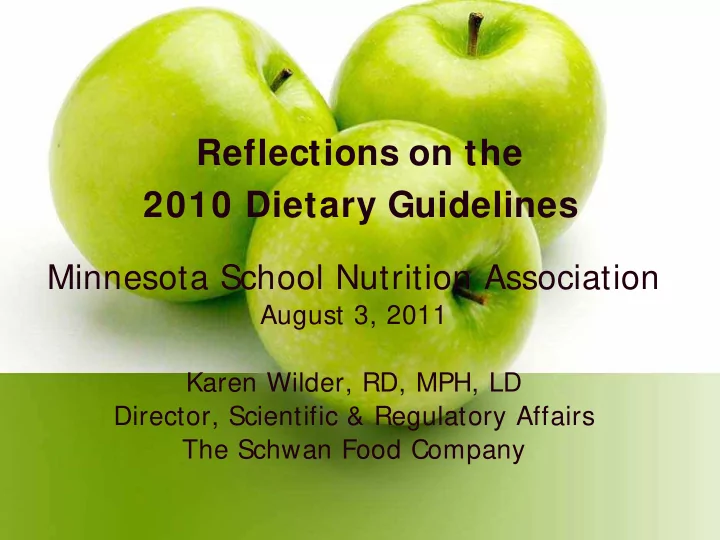

Reflections on the 2010 Dietary Guidelines Minnesota School Nutrition Association August 3, 2011 Karen Wilder, RD, MPH, LD Director, Scientific & Regulatory Affairs The Schwan Food Company
Today’s Agenda Overview of 2010 Dietary Guidelines Outcomes of Dietary Guidelines Food Industry Perspective Consumer Insights The Sodium Challenge A Peak behind the Curtain at Schwan
Evolution of Dietary Guidelines
Key Directives of the 2010 Dietary Guidelines for Americans Reduce the incidence and prevalence of overweight and obesity by reducing over calorie intake and increasing physical activity. Shift to a more plant-based intake pattern focused on vegetables, fruits, whole grains, nuts and legumes. Significantly reduce intake of foods containing added sugars and solid fats.
Dietary Guidelines Are Implemented in Federal Nutrition Programs
Outcomes from the DGAC Overnutrition Energy change dietary patterns and physical activity (lifestyle, behavior) Sodium 2,300 mg/day (~ 1 tsp salt) Recommend 1,500mg/d for at risk populations Current intake averages 3,400mg/d Saturated Fat – less than 10% of calories (replace with more mono- and polyunsaturated fats) Added sugar and refined grains contribute excess calories
Outcomes from the DGAC Undernutrition – nutrients of concern Calcium* Vitamin D* Dietary Fiber* Potassium* Magnesium Iron Folic Acid Vitamin B12 * Of particular concern for children
Outcomes from the DGAC Undernutrition – foods of importance Fluid milk – Non-fat and 1% milk products Vegetables – Dark green and orange Fruits Whole Grains Lean meat, poultry, fish, soy, eggs Legumes – cooked, dry beans Seeds and nuts – almonds, walnuts, peanuts, pistachios Vegetable oils to replace solid fats
Dietary Intake vs. Recommended Levels or Limits 9
Nutrition Recommendations and Public Policy Food policy must be based on Strong Scientific Evidence to: Insure recommendations will improve health 1. Avoid widespread consumer confusion 2. Increase public trust 3. Monitor policy impact on diet 4. and health
2010 Dietary Guidelines: Food Industry Perspective Assess consumer attitude towards nutrition and diet Test product concepts and protocepts Key challenges (opportunities) for industry: Sodium Saturated fat Whole grains Energy balance – “it’s about the calories” Portion control
Drivers of Food Choices Obvious fact to food companies If our food doesn’t taste good, people won’t buy it regardless of its health benefits. If people don’t buy the food, there is no chance to improve health Taste is the # 1 driver influencing food choices for adults and kids. Gatekeepers can engage kids by making healthy eating fun and cool.
Consumer Insights Awareness of DGAs Awareness of nutrition initiatives Consumer attitudes about obesity
2011 IFIC Consumer Research
How familiar are people with Nutrition Initiatives?
It’s a fine balance; keeping kids healthy and happy
Child Nutrition Reauthorization The October 2009 IOM Report - School ool Meals: Building Bloc ocks for Healt hy Children Recommended that USDA adopt standards for menu planning that: Increases the amount and variety of fruits, vegetables, whole grains Sets a minimum and maximum level of calories Focuses more on reducing saturated fat and sodium 18
Impact on School Meal Program Less use of processed products with increase the need for on-site food preparation Manufacturers will need to create products that meet lower fat and sodium requirements – Reformulation of products – Development of new products • Fruits frozen without sugar • Low sodium canned vegetables • Entrees with stealth health • Grain based foods made with 51% whole grain
Industry Challenges - Sodium Salt/Sodium has multiple unique functions Enhances other flavors Provides binding strength in meats Reduces bitterness Improves tenderness Microbial safety Reduces cooking loss in meats Promotes development of color in cooked meat products, Strengthens gluten in bread cereals, and bread dough for uniform texture and dough strength Controls fermentation in cheese and related products Bicarbonate – leavening in baking Minimizes ice-crystal formation in frozen products Ascorbate – vitamin C source Promotes firm texture in MSG – umami taste processed meats Citrate – pH regulation 20
A Closer Look at the Proposed Rule on Sodium for Schools Age/ Grade Baseline: Target 1: Target 2: Final % Change Group Current 2 years 4 years Target: 10 (Current Average from from years from Levels v. Sodium implemen- implemen- implemen- Final Levels as tation of tation of tation of Target) Offered final rule final rule final rule (mg) (mg) (mg) School Breakfast Program ≤540 ≤485 ≤430 K-5 573 -25% ≤600 ≤535 ≤470 6-8 629 -25% ≤640 ≤570 ≤500 9-12 686 -27% School Lunch Program ≤1,230 ≤935 ≤640 K-5 1,377 -54% ≤1,360 ≤1,035 ≤710 6-8 1,520 -53% ≤1,420 ≤1,080 ≤740 9-12 1,588 -53%
What We’ve Learned about Sodium Reduction We’re on a journey---it will take time for palates to adapt to less sodium and ingredient technologies to advance There is a broad commitment to decrease sodium across multiple categories Focus is on major contributors Decreases in sodium will take time The DGA goal over 50% reduction will require radical changes in food intake patterns Need to be vigilant for unintended consequences, e.g., safety, iodine status, consumer acceptance 22
A few more observations… Combinations of line extensions and gradual reductions will continue to be important, but may not achieve DGA goals A more radical shift in food intake patterns may be required Ideal technologies are not available in many instances Food regulations may be a barrier Food safety could be compromised Some terminologies are potentially misleading to consumers 23
Partnering for Success Together we: Can find ways to proactively convey positive messages of balanced nutrition Can be part of the solution to address childhood obesity and promote healthy eating among all children Tell your story – families want to know their children are getting the nutrition they need to do their best in school Will walk the talk
Peak Behind the Curtain In 2011-12 Schwan School Foodservice will launch 20 products that meet Healthier US School Challenge. Each provides: Not more than 10% calories from saturated fat Most with 51% whole grain Sodium of 600mg or less per serving No artificial (man made) trans fat Portion control complies with recommendations
Thank you! Question? Contact Information karen.wilder@schwans.com
Recommend
More recommend